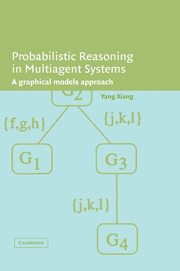Book contents
- Frontmatter
- Contents
- Preface
- 1 Introduction
- 2 Bayesian Networks
- 3 Belief Updating and Cluster Graphs
- 4 Junction Tree Representation
- 5 Belief Updating with Junction Trees
- 6 Multiply Sectioned Bayesian Networks
- 7 Linked Junction Forests
- 8 Distributed Multiagent Inference
- 9 Model Construction and Verification
- 10 Looking into the Future
- Bibliography
- Index
2 - Bayesian Networks
Published online by Cambridge University Press: 31 August 2009
- Frontmatter
- Contents
- Preface
- 1 Introduction
- 2 Bayesian Networks
- 3 Belief Updating and Cluster Graphs
- 4 Junction Tree Representation
- 5 Belief Updating with Junction Trees
- 6 Multiply Sectioned Bayesian Networks
- 7 Linked Junction Forests
- 8 Distributed Multiagent Inference
- 9 Model Construction and Verification
- 10 Looking into the Future
- Bibliography
- Index
Summary
To act in a complex problem domain, a decision maker needs to know the current state of the domain in order to choose the most appropriate action. In a domain about which the decision maker has only uncertain knowledge and partial observations, it is often impossible to estimate the state of the domain with certainty. We introduce Bayesian networks as a concise graphical representation of a decision maker's probabilistic knowledge of an uncertain domain. We raise the issue of how to use such knowledge to estimate the current state of the domain effectively. To accomplish this task, the idea of message passing in graphical models is illustrated with several alternative methods. Subsequent chapters will present representational and computational techniques to address the limitation of these methods.
The basics of Bayesian probability theory are reviewed in Section 2.2. This is followed in Section 2.3 by a demonstration of the intractability of traditional belief updating using joint probability distributions. The necessary background in graph theory is then provided in Section 2.4. Section 2.5 introduces Bayesian networks as a concise graphical model for probabilistic knowledge. In Section 2.6, the fundamental idea of local computation and message passing in modern probabilistic inference using graphical models is illustrated using so-called λ – π message passing in tree-structured models. The limitation of λ – π message passing is discussed followed by the presentation of an alternative exact inference method, loop cutset conditioning, in Section 2.7 and an alternative approximate inference method, forward stochastic sampling, in Section 2.8.
- Type
- Chapter
- Information
- Probabilistic Reasoning in Multiagent SystemsA Graphical Models Approach, pp. 16 - 36Publisher: Cambridge University PressPrint publication year: 2002
- 1
- Cited by

